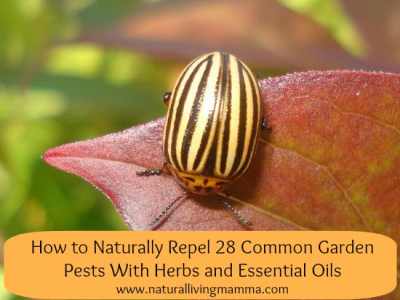 Spring is making way for summer, and with it comes an increase of insect activity. I personally love beneficial insects in and around my garden. They balance the eco-system and bring in predictors like wasps who kill caterpillars, or birds that eat the bugs and leave me nice bird manure as fertilizer, but some insects just take over and have got to go.
Spring is making way for summer, and with it comes an increase of insect activity. I personally love beneficial insects in and around my garden. They balance the eco-system and bring in predictors like wasps who kill caterpillars, or birds that eat the bugs and leave me nice bird manure as fertilizer, but some insects just take over and have got to go.
This is a compiled list of bugs we may not want around, along with essential oils that will repel them, and herbs that you can companion plant into your garden to repel these insects. I personally tend to keep onions, garlic, calendula and basil in my garden beds to repel the most common buggies, with mints, yarrow and lavender close at hand.
| Insect | Repelling Essential Oils |
Repelling Herbs |
| Ants
|
Cinnamon, Citronella, Citrus (any), Clove, Eucalyptus, Peppermint, Spearmint, Tansy
|
Bay, Calendula, Mint (any), Hyssop, Lavender, Marigold, Rue, Sage, Tansy, Woormwood, Yarrow
|
| Aphids
|
Cedarwood, Lemon, Peppermint, Spearmint
|
Garlic, Onions, Chives, Coriander, Hyssop
|
| Asparagus Beetle
|
Peppermint
|
Marigold, Petunia, Parsley, Garlic
|
| Bean Beetle
|
Peppermint, Thyme
|
Marigold, Nasturtium, Rosemary
|
| Cabbage Root Fly
|
Hyssop, Peppermint, Rosemary, Sage, Thyme
|
Peppermint, Rosemary, Sage, Thyme
|
| Cabbage Worms
|
Eucalyptus, Thyme
|
Coffee grounds, Borage, Clover, Geranium, Thyme
|
| Carrot Fly
|
Rosemary, Sage
|
Rosemary, Sage, Leeks, Garlic
|
| Caterpillars
|
Peppermint, Spearmint
|
Garlic, Onions, Chives, Leeks
|
| Cutworm
|
Sage, Thyme
|
Coffee Grounds, Egg Shells,
|
| Flea Beetle
|
Lavender, Lemongrass, Peppermint, Spearmint
|
Catmint, Mint(s)
|
| Fleas
|
Citronella, Lavender, Lemongrass, Peppermint
|
Lavender, Mint, Pennyroyal (toxic to cats)
|
| Flies
|
Citronella, Lavender, Peppermint
|
Basil, Rue, Rhubarb
|
| Gnats
|
Citronella, Patchoulli, Spearmint
|
Geranium, Lemon Thyme, Lavender, Mexican Marigold (Tagetes minuta)
|
| Grass Hoppers
|
Cilantro
|
Horehound, Calendula, Cilantro, Garlic Oil, Clover
|
| Lice
|
Cedarwood,Lavender, Melaleuca, Peppermint, Rosemary, Spearmint,Thyme
|
Rosemary, Lavender, Thyme
|
| Leaf Miners
|
Melaleuca, Cinnamon Leaf
|
Garlic
|
| Mosquitos
|
Citronella, lavender, lemongrass, Terrashield
|
Basil, Rosemary
|
| Nematodes
|
Sage, Citronella
|
Marigold, Chrysanthemum, Dahlia
|
| Potato Bugs
|
Catnip, Coriander,
|
Horehound, Horseraddish, Calendula, Cilantro, Garlic Oil, Clover, Marigold
|
| Slugs
|
Anise, Cedarwood, Pine, Rue
|
Woormwood, Rue, Fennel, Anise, Rosemary, Chevril |
| Snails
|
Cedarwood, Garlic, Patchouli, Pine, Rue
|
Coffee Grounds, Egg Shells, Crushed Nut Shells |
| Squash Bugs
|
Basil, Eucalyptus, Peppermint, Orange, Lemongrass
|
Cloves, Onions, Garlic, Nasturtium, Raddish, Cilantro, Lemongrass, Sage
|
| Ticks
|
Citronella, Lemongrass, Thyme, Sage
|
Lavender
|
| Tomato Hornworm
|
Peppermint
|
Borage, Garlic Oil, Pot Marigold, Petunia
|
| Weevils
|
Cedarwood, Patchouli
|
Catnip
|
| White Fly
|
Lavender, Sage, Tansy
|
Nasturtium
|
| White Moth
|
Sage, Rosemary, Mint, Oregano, Thyme
|
Hyssop, Mint, Oregano, Rosemary, Sage, Tansy, Thyme
|
| Wooly Aphids
|
Patchouli, Pine, Sandalwood
|
How to use the essential oils
Using essential oils in the garden takes some discretion. Don’t just dump undiluted essential oils in your soil and expect good things to happen. Sure it will repel those moths, but it will also damage your soil composition where the undiluted oil is. Instead, get some scrap cloth and tie it to a lattice, or a strong stocked plant in your garden like broccoli, fava beans, corn, or sunflowers. On the piece of cloth dab a drop or two of your oil blend of choice. Re-apply every 3 days or after a rain storm.
You can also put 10-15 drops of your essential oil blend into a spray bottle with 2 cups of water. Shake the bottle very well right before use (the oil floats to the top) and spray your plants on the top and bottom of the leaves to repel those pesky insects.
You can place cotton balls with a few drops of your EO solution on it throughout your garden.
How to use herbs to repel insects
This is my first line of defense for pest prevention. Instead of planting rows of food I disburse plants that need different resources and different parts of the ground so the bugs can’t just swarm my garden. For example, in one plot I will plant corn at the back, while the corn is growing I will then plant beans. The beans can climb up the corn and protect the stocks. I also plant squash at the base of the corn and peas. This will create ground cover and keep the roots cool. Between these rows of “three sisters” I plant garlic, onions, and radish, which repel the common bugs that eat squash, beans, and corn. This creates a bio-diverse garden that uses both vertical garden methods, traditional knowledge (the three sisters is how native Americans grew their corn fields), and uses different soil depths. The radish digs deep into the soil loosening it and allowing water to reach deep into the ground, the onions and garlic have a medium depth root that will expand and utilize ground that the squash, beans, and corn will not.
SOURCE : naturallivingmamma.com


